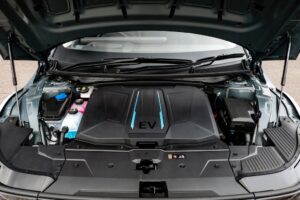The lithium-ion batteries powering electric cars can be reused or recycled at the end of the vehicle’s lifespan. Here’s why EV battery recycling is key in the transition.

One of the big questions in the minds of potential EV drivers is about the lifecycle of the vehicle’s battery — particularly what happens to it in the afterlife. Photo: Hyundai Canada
The lithium-ion batteries powering electric cars can be reused or recycled at the end of the vehicle’s lifespan. Here’s why EV battery recycling is key in the transition
This article is Sponsor Content presented by Hyundai Canada.
One of the big questions in the minds of potential EV drivers is about the lifecycle of the vehicle’s battery — particularly what happens to it in the afterlife.
This is a great question and one that Hyundai has put significant time and energy into developing a solution for.
Hyundai was one of the first automakers to sign a deal with a battery recycler (Lithion in Quebec) to handle our batteries once they reach end-of-life. We know battery recycling is a growing market and as more EVs hit the road the importance of having a recycling plan in place is paramount.
How are electric vehicle batteries recycled?
EV batteries go through a multi-step recycling process. First the batteries are claimed by a recycler (in Hyundai’s case, Lithion) and taken to their facility to be broken down.
The battery is fed whole into a machine that shreds it. Then those shreds are put through a machine that separates the different components — minerals, metals and plastics.
Up to 95 per cent of the components recovered by Lithion can be recycled and fed back into the supply chain.
Is there enough lithium for electric cars?
There is an abundance of lithium worldwide. The catch is that not all of it is battery grade and much of it is not being mined.
In order to meet a fully electric vehicle market, lithium mining and refining will need to increase in sync with EV adoption.
What can be reused from a recycled battery?
The minerals, metals and plastics in the Kona and Ioniq batteries can be separated out in the recycling process.
Having a circular supply chain greatly reduces the strain on mining and manufacturing to keep feeding the auto sector with raw materials.
What else can I do with my battery?
Most EV batteries, once a vehicle is retired, are not ready to be recycled. Increasingly EV batteries — including those in the Konas and Ioniqs — are seeing second life applications in grid energy storage projects.
In this role the (former) EV batteries act as energy banks that charge up when grid demand is low and then discharge into the grid when demand is high to offset the need for excess energy generation through high emitting sources.
Does it cost anything to recycle my EV battery?
No. Recycling EV batteries does not cost the consumer anything. The onus is on automakers to make sure their vehicles’ batteries are properly recycled at end-of-life.
How long does my EV battery last?
The lifespan of an EV battery isn’t known precisely because they haven’t been around long enough and in a significant enough volume to measure. The market average is 10-20 years and Hyundai is confident that the batteries in the Kona and Ioniq models will stand the test of time.
And, if it’s any indication about battery longevity: the EV battery recycling market is maturing slowly because the supply of EV batteries is far lower than recyclers were anticipating due to them lasting such a long time.







